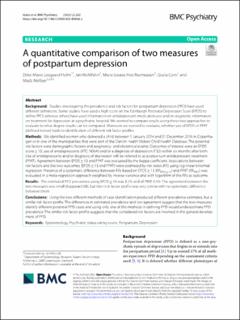| dc.contributor.author | Holm, Ditte-Marie Leegaard | |
| dc.contributor.author | Wohlfahrt, Jan | |
| dc.contributor.author | Rasmussen, Marie-Louise Hee | |
| dc.contributor.author | Corn, Giulia | |
| dc.contributor.author | Melbye, Mads | |
| dc.date.accessioned | 2022-05-25T06:50:28Z | |
| dc.date.available | 2022-05-25T06:50:28Z | |
| dc.date.created | 2022-04-11T16:37:27Z | |
| dc.date.issued | 2022 | |
| dc.identifier.citation | BMC Psychiatry. 2022, 22 (1), . | |
| dc.identifier.issn | 1471-244X | |
| dc.identifier.uri | https://hdl.handle.net/11250/2996057 | |
| dc.description.abstract | Background: Studies investigating the prevalence and risk factors for postpartum depression (PPD) have used different definitions. Some studies have used a high score on the Edinburgh Postnatal Depression Scale (EPDS) to define PPD, whereas others have used information on antidepressant medication use and/or diagnostic information on treatment for depression at a psychiatric hospital. We wanted to compare results using these two approaches to evaluate to what degree results can be compared. Moreover we wanted to evaluate, whether use of EPDS or PPAT (defined below) leads to identification of different risk factor profiles. Methods: We identified women who delivered a child between 1 January 2014 and 31 December 2016 in Copenhagen or in one of the municipalities that were part of the Danish Health Visitors' Child Health Database. The potential risk factors were demographic factors and pregnancy- and obstetrical events. Outcomes of interest were an EPDS score ≥ 13, use of antidepressants (ATC: N06A) and/or a diagnosis of depression (F32) within six months after birth. Use of antidepressants and/or diagnosis of depression will be referred to as postpartum antidepressant treatment (PPAT). Agreement between EPDS ≥ 13 and PPAT was evaluated by the kappa coefficient. Associations between risk factors and the two outcomes (EPDS ≥ 13 and PPAT) were estimated by risk ratios (RR) using log-linear binomial regression. Presence of a systematic difference between RRs based on EPDS ≥ 13 (RREPDS≥13) and PPAT (RRPPAT) was evaluated in a meta-regression approach weighted by inverse-variance and with logarithm of the RRs as outcome. Results: The estimated PPD prevalence using EPDS ≥ 13 was 3.2% and of PPAT 0.4%. The agreement between the two measures was small (Kappa = 0.08), but their risk factor profile was very similar with no systematic difference between them. Conclusions: Using the two different methods of case identification produced different prevalence estimates, but a similar risk factor profile. The differences in estimated prevalence and low agreement suggest that the two measures identify different potential PPD cases and using only one of the methods in defining PPD would underestimate PPD prevalence. The similar risk factor profile suggests that the considered risk factors are involved in the general development of PPD. Keywords: Depression; Epidemiology; Postpartum; Psychiatric status rating scales. | |
| dc.description.abstract | A quantitative comparison of two measures of postpartum depression | |
| dc.language.iso | eng | |
| dc.title | A quantitative comparison of two measures of postpartum depression | |
| dc.title.alternative | A quantitative comparison of two measures of postpartum depression | |
| dc.type | Peer reviewed | |
| dc.type | Journal article | |
| dc.description.version | publishedVersion | |
| dc.source.pagenumber | 0 | |
| dc.source.volume | 22 | |
| dc.source.journal | BMC Psychiatry | |
| dc.source.issue | 1 | |
| dc.identifier.doi | 10.1186/s12888-022-03836-z | |
| dc.identifier.cristin | 2016826 | |
| cristin.ispublished | true | |
| cristin.fulltext | original | |
| cristin.qualitycode | 2 | |
